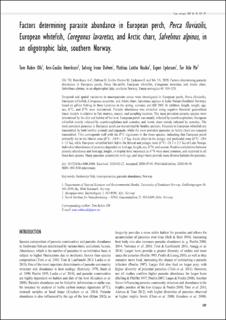| dc.contributor.author | Olk, Tom Robin | |
| dc.contributor.author | Henriksen, Ann-Cecilie | |
| dc.contributor.author | Dolven, Solveig Irene | |
| dc.contributor.author | Haukø, Mathias Leithe | |
| dc.contributor.author | Lydersen, Espen | |
| dc.contributor.author | Mo, Tor Atle | |
| dc.date.accessioned | 2020-09-28T10:14:14Z | |
| dc.date.available | 2020-09-28T10:14:14Z | |
| dc.date.created | 2020-09-23T11:28:01Z | |
| dc.date.issued | 2020 | |
| dc.identifier.citation | Olk, T. R., Henriksen, A. C., Dolven, S. I., Haukø, M. L., Lydersen, E., & Mo, T. A. (2020). Factors determining parasite abundance in European perch, Perca fluviatilis, European whitefish, Coregonus lavaretus, and Arctic charr, Salvelinus alpinus, in an oligotrophic lake, southern Norway. Fauna norvegica, 40, 109-129. | en_US |
| dc.identifier.issn | 1502-4873 | |
| dc.identifier.uri | https://hdl.handle.net/11250/2679926 | |
| dc.description.abstract | Temporal and spatial variations in macroparasite status were investigated in European perch, Perca fluviatilis, European whitefish, Coregonus lavaretus, and Arctic charr, Salvelinus alpinus in Lake Norsjø (Southern Norway), based on gillnet fishing in three locations in the spring, summer, and fall 2018. In addition, length, weight, age, sex, δ13C, and δ15N were determined. Parasite abundance was modelled using negative binomial generalized linear models in relation to fish metrics, season, and sampling location. The most prevalent parasite species were determined by the diet and habitat of the host. European perch was mainly infected by acanthocephalans, European whitefish mainly infected by acanthocephalans and cestodes, and Arctic charr mainly infected by cestodes. The most prevalent parasites in European perch are transmitted by benthic animals. Parasites in European whitefish are transmitted by both benthic animals and copepods, while the most prevalent parasites in Arctic charr are copepod transmitted. This corresponds well with the δ13C signatures in the three species, indicating that European perch primarily fed in the littoral zone (δ13C: -24.9 ± 2.5 ‰), Arctic charr in the pelagic and profundal zone (δ13C: -29.4 ± 1.1 ‰), while European whitefish both fed in the littoral and pelagic zone (δ13C: -28.3 ± 2.3 ‰) of Lake Norsjø. Individual abundances of parasites depended on host age, length, sex, δ15N, and season. Positive correlations between parasite abundance and host age, length, or trophic level measured as δ15N were most common, and occurred in all three host species. Many parasites accumulate with age, and larger hosts provide more diverse habitats for parasites. | en_US |
| dc.language.iso | eng | en_US |
| dc.rights | Navngivelse 4.0 Internasjonal | * |
| dc.rights.uri | http://creativecommons.org/licenses/by/4.0/deed.no | * |
| dc.title | Factors determining parasite abundance in European perch, Perca fluviatilis, European whitefish, Coregonus lavaretus, and Arctic charr, Salvelinus alpinus, in an oligotrophic lake, southern Norway | en_US |
| dc.type | Peer reviewed | en_US |
| dc.type | Journal article | en_US |
| dc.description.version | publishedVersion | en_US |
| dc.subject.nsi | VDP::Zoologiske og botaniske fag: 480 | en_US |
| dc.subject.nsi | VDP::Zoology and botany: 480 | en_US |
| dc.source.pagenumber | 109-129 | en_US |
| dc.source.volume | 40 | en_US |
| dc.source.journal | Fauna Norvegica | en_US |
| dc.identifier.doi | https://doi.org/10.5324/fn.v40i0.3444 | |
| dc.identifier.cristin | 1832438 | |
| cristin.ispublished | true | |
| cristin.fulltext | original | |
| cristin.qualitycode | 1 | |

